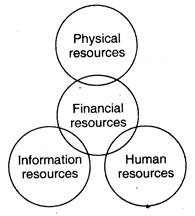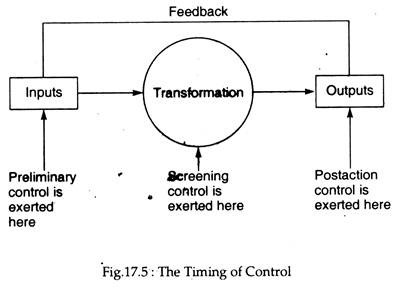After reading this article you will learn about:- 1. Importance of Control 2. Fundamentals of Control 3. Focus 4. Types.
Importance of Control:
Controlling is the last of the five functions of management. It is considered last, not because it is less important than the other four functions: planning, organizing, staffing and leading but because it affects and is affected by the other four functions.
As Earl Strong and Robert D. Smith have rightly commented:
“A combination of well-planned objectives, strong organisation, capable direction and motivation have little-probability of success unless there exists an adequate system of control.”
The control function essentially insures that planned performance is achieved with a minimum of disorder and disruptions. It assures that plans are carried out and objectives are reached. Planning, organizing, staffing and directing (leading) must be properly monitored to maintain their effectiveness and efficiency.
Hence, there is a real need for competent people to plan, organise and direct a control system that will be effective.
Fundamentals of Control:
In truth, organisational life is replete with daily examples of poor control. Poor control may be reflected in project cost over-runs, schedules not being completed on time, poor-quality service or products, botched opportunities and so on. Managerial control consists of the things that management does to ensure that plans are accomplished as intended.
Various names are given to the control function. It is often called evaluating, appraising, or correcting.
But the term ‘control’ seems to be appropriate because none of the other terms carries the connotation of:
(1) Setting standards,
(2) Measuring actual performance, and
(3) Taking corrective action.
Control, the last of the basic functions of management, can be defined as “the regulation of organisational activity in such a way as to facilitate goal attainment”. For example, an organisation might find that if desired profits levels are to be maintained, its manufacturing costs must not exceed Rs 40 per unit.
A system would then be established to provide ongoing cost information to management. If costs rise above Rs 40, some action would be taken to reduce costs to the desired level. Such actions might be raising productivity, changing suppliers to buy less expensive materials, or recycling defective products.
In this example, the desired levels of profitability are the goals of the organisation and the regulation of activities required to attain those goals is the management of production costs.
Focus of Control:
Organisational control can focus a particular organisation activity or a set of activities. Controls can be classified in terms of the organisation’s four basic resources: financial, physical, human and information. See Fig. 17.1. The management process itself involves efficiently and effectively combining these four resources to product saleable goods (or appropriate outputs).
Fig 17.1 The Focus of Organisational Control
Control of physical resources includes inventory management (holding or stock neither a small quantity nor a large quantity or finishing goods and/or raw materials and intermediate goods or goods-in-process), quality control (maintaining the appropriate level of output quality) and capital equipment control (having the proper kinds of buildings, office equipment and so on).
Control of human resources includes proper selection and placement activities, employee training and development, job evaluation and merit rating and performance appraisal.
Finally, the control of information resources involves such things as accurate sales and markets, forecasting, adequate environmental analysis, public relations, production scheduling and economic forecasting.
Fig. 17.1 shows that financial resources are at the centre of organisation control. The reason is simple enough. Financial resources, beyond being organisational resources in their own right, are inseparably linked up with the control of all other (non-financial) resources.
We often come across pure financial control such as ensuring that the organisation always has enough cash on hand to meet its obligations but that it does not have excess cash lying around in bank account.
However, we also find that financial control extends to the three other kinds of resources as well: excess inventory raises storage costs’ poor selection of personnel leads to termination and rehiring expenses; inaccurate sales forecasts lead to disruptions in cash flows and other financial effect. All these are bad for the organisation. Therefore, financial issues tend to pervade most control-related activities.
Types of Controls:
We may now describe various types of control to be able to ascertain what kinds of control or control systems are available for managers to use.
Cybernetic versus Non-Cybernetic Control:
Cybernetic control monitors and manages a process by means of a self-regulating mechanism. The key feature of such control is a strong feedback mechanism.
An organisation might set up a simple system to monitor and manage its inventory of a certain raw material. A computerised ordering system might order the material until inventory reaches a certain level. Then, until inventory falls back below a certain level, no more orders are issued. This means that, in effect, the system controls itself.
By contrast, non-cybernetic control requires an external monitoring system. When, for example, a company’s inventory system does not monitor and manage itself, it has to be controlled by an external agent such as a purchasing manager.
Types of Control According to Timing:
It is quite possible for an organisation to introduce control at one or more of three general points : before, during or after the resource transformation process. Fig. 17.5 shows how control can focus on the inputs to the transformation process, or the transformation itself, or on its outputs.
i. Preliminary Control:
Such control also goes by the name steering control (or feed-forward control) — concentrates on inputs to the system early in the overall process. Preliminary control seeks to monitor the quantity or quality of financial, physical, human and information resources before they become a part of the system.
Organisations are often required to take appropriate measures to control financial and information resources as they enter the system.
ii. Screening Control:
Such control, also known as the ‘yes/no control’ or concurrent control, takes place during the actual transformation process and relies heavily on feedback processes. So screening controls are much like cybernetic controls and occurs during the actual transformation of the product.
Such controls are more widely used than other forms of control mainly because they are widely applicable and useful in identifying the cause of problems.
iii. Post-Action Control:
Such control focuses on the outputs of the organisation after the completion of the transformation process. Although not that useful like the previous two types of control, it is effective in two important ways. Firstly, it provides management with information for future planning.
Secondly, it provides a basis for rewarding employees. Recognising that an employee has exceeded his (her) sales goals (planned outputs) by a wide margin, for example, may alert the manager that a bonus or promotion is in order.

